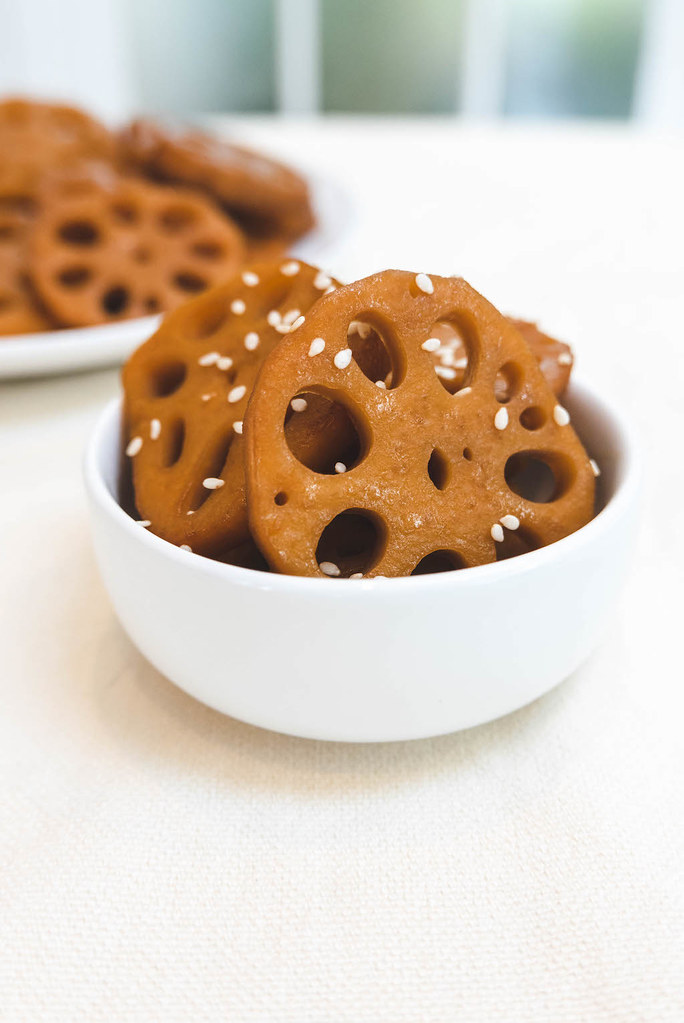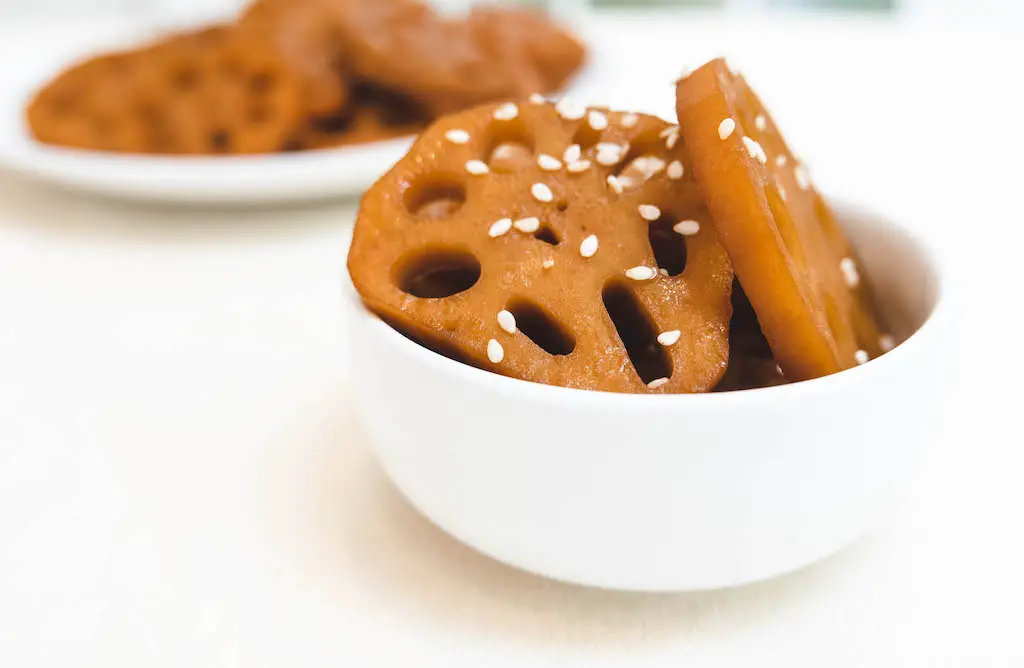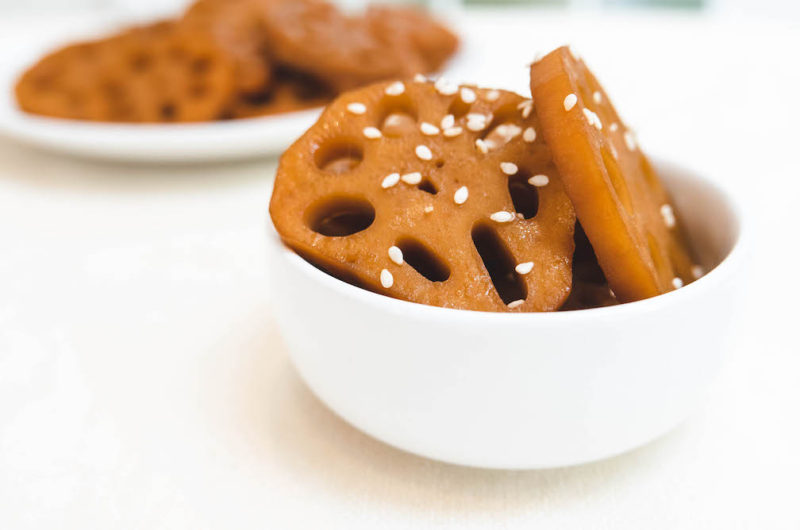This post may contain affiliate links. Please read my disclosure for details at the bottom of this page. As an Amazon Associate, I earn from qualifying purchases on this Korean braised lotus root recipe post.
As we continue to inch closer and closer to the autumn season, I have started to think about cooking with fall season crops. Of late, I dream of autumn recipes such as roasted root vegetables and scalloped potatoes.
As such, I started to learn how to cook with lotus roots! This edible subterranean stem comes into season and is harvested in late summer through the fall months. Recently, I fell in love with the mild and slightly sweet flavor! Now, I am exploring different ways to cook it.
In Korea, braised lotus roots, known as yeongeun jorim, are a popular side dish. People often make this at home and enjoy eating it as a side dish in restaurants. Actually, most schools prepare this side dish for the cafeteria school lunches because of its great source of fiber and vitamin C.
Below, we list some facts about the lotus plant as well as answer potential questions you may have about this recipe! We hope you enjoy it!

Facts About the Lotus Plant:
The lotus plant, also known as the Indian lotus, sacred lotus, or water lily, is a type of aquatic vegetation. These plants have large, beautiful flowers and green ‘lily pad’ leaves.
Lotus plants grow in the muddy parts of shallow and still water. You can see them in flooded fields, lagoons, ponds, slowly flowing rivers, and marshes. Originally, these plants were native to Asia, Australia, New Guinea, and parts of the Middle East. Now, they have spread to other areas of the world as beautiful additions to water features! In the art world, Monet famously painted these plants in his water lilies series after growing them in the pond on his property.
Interestingly, almost every part of the plant is edible! One of these parts, the lotus root, is a popular ingredient in many East Asian cuisines. The lotus roots are typically harvested at the beginning from August through the fall. While the roots are cylindrical, once sliced across, you will find flower petal-shaped designs with small holes.

What is Yeongeun Jorim (연근조림)?
In South Korea, lotus roots are known as ‘yeongeun’ (연근). This ingredient is commonly used in soups as well as stir-fried and braised dishes. Most famously, it is used in a braised dish known as ‘yeongeun jorim’ (연근조림), which we are making today!
Yeongeun jorim is a popular type of side dish, known as ‘banchan’ in the Korean language. To make this traditional banchan, you braise the lotus roots in a soy sauce-based sauce until all the liquid cooks down. Often, people serve these braised lotus roots as a side dish in restaurants as well as in school cafeteria lunches.
Korean Braised Lotus Root Frequently Asked Questions:
Below, we listed some questions you may have about this Korean braised lotus root recipe. If we do not answer your question below, feel free to leave a comment or email us at [email protected]!
Do I Need to Use Fresh Lotus Roots?
Honestly, it can be difficult to find fresh lotus roots in certain areas of the world. Often, local Asian grocery stores do not even carry fresh versions. Below, I will give tips for using fresh lotus roots and preserved lotus roots!
- Fresh Lotus Roots: If you can find fresh roots, you need to clean and prep them. To do so, you need to cut off the ends of the root. Then peel the outside of the roots with a vegetable peeler. Finally, slice the across the root approximately ¼ inch thick. You then need to blanch them.
- Preserved Lotus Roots: In Asian grocery stores, you can find pre-cut and packaged lotus roots. These roots are already blanched and are stored in vinegar. To prep these, you need to wash the lotus roots in cold water a few times to remove the vinegar flavor!
So, no you do not need fresh lotus roots. If you cannot find fresh ones, feel free to use the packaged versions!

Is This Korean Braised Lotus Root Recipe Free of Major Allergens? (Gluten, Soy, Dairy, Etc.)
This recipe does typically contain two major allergens: gluten and soy. Soy sauce is made primarily of soybeans and typically contains wheat. If you have either of these allergies, you can replace the soy sauce with alternate ingredients.
To make this recipe gluten-free, you can replace the soy sauce with gluten-free tamari. If you need recommendations, check out our post listed some gluten-free soy sauce alternatives!
You can also make this recipe soy-free using coconut aminos. If you use this ingredient, add a little less honey because coconut aminos tend to be a bit sweeter than your typical soy sauce.
For those with either of these allergies, I recommend avoiding yeongeun jorim in restaurants in South Korea.
Can You Make This Korean Braised Lotus Recipe In Advance?
Yes! You can make this braised lotus root recipe in advance! In Korea, at home, people often make the banchan for the week on one day. They then store them in the refrigerator to serve on the side of the main dishes.
You can make yeongeun jorim in advance and keep it in the refrigerator for up to a week!
How Do I Store Leftover Yeongeun Jorim? How Do I Reheat Leftovers?
To store these braised lotus roots, place them in an airtight container. Then, store them in the refrigerator. You can continue to eat them for up to a week.
Typically, people do not reheat these when serving them throughout the week. Yeongeun jorim tastes delicious whether they are hot, at room temperature, or cold!

We Hope You Enjoyed Learning About This Korean Braised Lotus Root Recipe
In the end, we hope you enjoyed learning about this Korean braised lotus root recipe. If so, let us know in the comment section below. Also, we would love to hear about your favorite types of Korean jeon!
If you would like to read more about cooking, you can find further recipes on our blog. We listed some of our favorite Carving A Journey Korean recipes below! For reference, many recipes are influenced by our blended Korean and Southern heritage.
Carving A Journey Korean Recipes:
- Tteokkochi (Korean Rice Cake Skewers)
- Jumeokbap (Handmade Korean Rice Balls)
- Strawberry Matcha Latte Recipe
- Soju Caipirinha (A Korean Take on Brazil’s National Drink)
- Bibimmyeon (Korean Spicy Cold Noodles)
- Korean Strawberry Milk Recipe
- Brown Sugar Iced Latte (Korean Burnt Sugar Latte); And
- Korean Banana Flavored Milk
If you have any questions or comments, you can also email us at [email protected].
And, finally, we would love to hear from you through our social media as well! You can follow us at @carvingajourney on Instagram, Twitter, Facebook, and Pinterest. Or, if you would like more articles like these, you can subscribe to our blog by joining our mailing list. We hope you enjoyed reading about this Korean braised lotus root (yeongeun jorim) recipe! Thank you so much for stopping by!
Carving A Journey is a participant in the Amazon Services LLC Associates Program, an affiliate advertising program designed to provide a means for sites to earn advertising fees by advertising and linking to Amazon.com. Although we may earn commissions for our endorsement, recommendation, testimonial, and/or link to any products or services from this website, these opinions are my own and I fully support these products.


